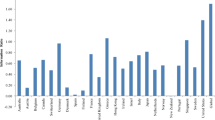Abstract
Google search volumes have proven to be useful in portfolio management. The basic idea is that high search volumes are related to bad news and risk increase. This paper shows additional evidence about the use of Google search volumes in risk management, for the Dow Jones Industrial Average index components from 2004 to 2017. To overcome the (time-series and cross-section) limitations Google imposes on data download, a renormalization procedure is presented, to obtain a multivariate sample of volumes, which preserve their relative magnitude. The results indicate that the volume normalization is relevant for portfolio performances. Renormalized Google search volumes yield poor results when they penalize the portfolio diversification. Instead, if the portfolio diversification can be kept to an acceptable level, the renormalized Google search volumes contribute to improving risk-adjusted performances.








Similar content being viewed by others
Notes
Potentially, the situation can be even more severe. Consider, for example, the joint download of “Pfizer” and “The Home Depot”, where the GI of “Pfizer” is flattened to 1, losing all relative and dynamical information.
Kristoufek (2015) proposes a comparison between the use of web search volumes in-sample and out-of-sample. In this paper, we only consider the so called out-of-sample analysis, which is appropriate to build an asset allocation rule.
Recall that the Gini coefficient is a concentration measure widely used in economics and statistics, principally to analyze income inequalities (see Gini 2005). The Gini coefficient ranges from 0 (perfect equality: all the individuals have the same income) to 1 (maximum concentration: 1 individual earns all the income in the economy). In this paper, we use the Gini coefficient as a portfolio concentration measure. This way, we have an indicator of the diversification of the considered portfolios. Here and in the following, we report the Gini coefficient of the average portfolio weights on the considered period: \(\mathrm {Gini}\left( \frac{1}{T}\sum _{t=1}^T w_t\right) \), where \(w_t\) is the vector of the portfolio weights at time \(t\).
Remark that the Gini coefficient of the weights of common stock indexes is around 0.5 or below.
The qualitative behavior of the indicators for \(k=4,5,6\) is similar to the one with \(k=3\). For the sake of interest and space, we do not report the results for such values of \(k\), although they are available upon request.
References
Alanyali, M., Moat, H. S., & Preis, T. (2013). Quantifying the relationship between financial news and the stock market. Scientific Reports, 3, 3578.
Askitas, N., & Zimmermann, K. F. (2009). Google econometrics and unemployment forecasting. Applied Economics Quarterly, 55(2), 107–120.
Bijl, L., Kringhaug, G., Molnár, P., & Sandvik, E. (2016). Google searches and stock returns. International Review of Financial Analysis, 45, 150–156.
Da, Z., Engelberg, J., & Gao, P. (2011). In search of attention. The Journal of Finance, 66(5), 1461–1499.
Dzielinski, M. (2012). Measuring economic uncertainty and its impact on the stock market. Finance Research Letters, 9(3), 167–175.
Gini, C. (2005). On the measurement of concentration and variability of characters. METRON-International Journal of Statistics, 63(1), 1–38.
Ginsberg, J., Mohebbi, M. H., Patel, R. S., Brammer, L., Smolinski, M. S., & Brilliant, L. (2009). Detecting influenza epidemics using search engine query data. Nature, 457, 1012–1014.
Goel, S., Hofman, J. M., Lahaie, S., Pennock, D. M., & Watts, D. J. (2010). Predicting consumer behaviour with web search. Proceedings of the National Academy of Sciences, 107(41), 1–5.
Heiberger, R. H. (2015). Collective attention and stock prices: Evidence from google trends data on standard and poor’s 100. PLoS One, 10(8), e0135311.
Joseph, K., Wintoki, M. B., & Zhang, Z. (2011). Forecasting abnormal stock returns and trading volume using investor sentiment: evidence from online search. International Journal of Forecasting, 27(4), 1116–1127.
Kristoufek, L. (2013). Can google trends search queries contribute to risk diversification? Scientific Reports, 3, 2713.
Kristoufek, L. (2015). Power-law correlations in finance-related google searches, and their cross-correlations with volatility and traded volume: Evidence from the dow jones industrial components. Phisica A, 428, 194–205.
Li, X., Ma, J., Wang, S., & Zhang, X. (2015). How does google search affect trader positions and crude oil prices? Economic Modeling, 49, 162–171.
Liu, Y., Chen, Y., Wu, S., Peng, G., & Lv, B. (2015). Composite leading search index: A preprocessing method of internet search data for stock trends prediction. Annals of Operations Research, 234(1), 77–94.
Maillard, S., Roncalli, T., & Teïletche, J. (2010). The properties of equally weighted risk contribution portfolios. Journal of Portfolio Management, 36(1), 60–70.
Mondria, J., Wu, T., & Zhang, Y. (2010). The determinants of international investment and attention allocation: Using internet search query data. Journal of International Economics, 82(1), 85–95.
Polgreen, P. M., Chen, Y., & Pennock, D. M. (2008). Using internet searches for influenza surveillance. Clinical Infectious Diseases, 47, 1443–1448.
Preis, T., Moat, H. S., & Stanley, E. (2014). Quantifying trading behavior in financial markets using google trends. Scientific Reports, 3, 1684.
Vlastakis, N., & Markellos, R. N. (2012). Information demand and stock market volatility. Journal of Banking & Finance, 36(6), 1808–1821.
Vozlyublennaia, N. (2014). Investor attention, index performance, and return predictability. Journal of Banking & Finance, 41, 17–35.
Acknowledgements
We would like to thank two anonymous Referees for their useful suggestions that helped us to improve the paper.
Author information
Authors and Affiliations
Corresponding author
Additional information
Publisher's Note
Springer Nature remains neutral with regard to jurisdictional claims in published maps and institutional affiliations.
Rights and permissions
About this article
Cite this article
Maggi, M., Uberti, P. Google search volumes for portfolio management: performances and asset concentration. Ann Oper Res 299, 163–175 (2021). https://doi.org/10.1007/s10479-019-03424-7
Published:
Issue Date:
DOI: https://doi.org/10.1007/s10479-019-03424-7




